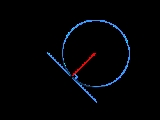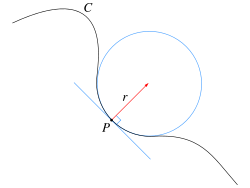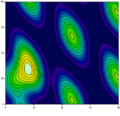
Multivariable calculus
Encyclopedia
Multivariable calculus is the extension of calculus
in one variable
to calculus in more than one variable: the differentiated and integrated functions involve multiple variables, rather than just one.
and continuity
in multiple dimensions yields many counter-intuitive results not demonstrated by single-variable functions. There exist, for example, scalar functions of two variables having points in their domain which, when approached along any arbitrary line, give a particular limit, yet give a different limit when approached along a parabola. The function
approaches zero along any line through the origin. However, when the origin is approached along a parabola y = x2, it has a limit of 0.5. Since taking different paths toward the same point yields different values for the limit, the limit does not exist.
Partial derivatives may be combined in interesting ways to create more complicated expressions of the derivative. In vector calculus, the del
operator ( ) is used to define the concepts of gradient
) is used to define the concepts of gradient
, divergence
, and curl in terms of partial derivatives. A matrix of partial derivatives, the Jacobian matrix, may be used to represent the derivative of a function between two spaces of arbitrary dimension. The derivative can thus be understood as a linear transformation
which varies from point to point in the domain of the function.
Differential equations containing partial derivatives are called partial differential equations or PDEs. These equations are generally more difficult to solve than ordinary differential equations, which contain derivatives with respect to only one variable.
guarantees that a multiple integral may be evaluated as a repeated integral.
The surface integral
and the line integral
are used to integrate over curved manifolds such as surfaces and curves.
In a more advanced study of multivariable calculus, it is seen that these four theorems are specific incarnations of a more general theorem, the generalized Stokes' theorem, which applies to the integration of differential forms over manifolds.
Multivariable calculus can be applied to analyze deterministic
systems that have multiple degrees of freedom
. Functions with independent variable
s corresponding to each of the degrees of freedom are often used to model these systems, and multivariable calculus provides tools for characterizing the system dynamics
.
Multivariable calculus is used in many fields of natural and social science and engineering to model and study high-dimensional systems that exhibit deterministic behavior. Non-deterministic, or stochastic
systems can be studied using a different kind of mathematics, such as stochastic calculus
.
Calculus
Calculus is a branch of mathematics focused on limits, functions, derivatives, integrals, and infinite series. This subject constitutes a major part of modern mathematics education. It has two major branches, differential calculus and integral calculus, which are related by the fundamental theorem...
in one variable
Variable (mathematics)
In mathematics, a variable is a value that may change within the scope of a given problem or set of operations. In contrast, a constant is a value that remains unchanged, though often unknown or undetermined. The concepts of constants and variables are fundamental to many areas of mathematics and...
to calculus in more than one variable: the differentiated and integrated functions involve multiple variables, rather than just one.
Limits and continuity
A study of limitsLimit of a function
In mathematics, the limit of a function is a fundamental concept in calculus and analysis concerning the behavior of that function near a particular input....
and continuity
Continuous function
In mathematics, a continuous function is a function for which, intuitively, "small" changes in the input result in "small" changes in the output. Otherwise, a function is said to be "discontinuous". A continuous function with a continuous inverse function is called "bicontinuous".Continuity of...
in multiple dimensions yields many counter-intuitive results not demonstrated by single-variable functions. There exist, for example, scalar functions of two variables having points in their domain which, when approached along any arbitrary line, give a particular limit, yet give a different limit when approached along a parabola. The function

approaches zero along any line through the origin. However, when the origin is approached along a parabola y = x2, it has a limit of 0.5. Since taking different paths toward the same point yields different values for the limit, the limit does not exist.
Partial differentiation
The partial derivative generalizes the notion of the derivative to higher dimensions. A partial derivative of a multivariable function is a derivative with respect to one variable with all other variables held constant.Partial derivatives may be combined in interesting ways to create more complicated expressions of the derivative. In vector calculus, the del
Del
In vector calculus, del is a vector differential operator, usually represented by the nabla symbol \nabla . When applied to a function defined on a one-dimensional domain, it denotes its standard derivative as defined in calculus...
operator (
 ) is used to define the concepts of gradient
) is used to define the concepts of gradientGradient
In vector calculus, the gradient of a scalar field is a vector field that points in the direction of the greatest rate of increase of the scalar field, and whose magnitude is the greatest rate of change....
, divergence
Divergence
In vector calculus, divergence is a vector operator that measures the magnitude of a vector field's source or sink at a given point, in terms of a signed scalar. More technically, the divergence represents the volume density of the outward flux of a vector field from an infinitesimal volume around...
, and curl in terms of partial derivatives. A matrix of partial derivatives, the Jacobian matrix, may be used to represent the derivative of a function between two spaces of arbitrary dimension. The derivative can thus be understood as a linear transformation
Linear transformation
In mathematics, a linear map, linear mapping, linear transformation, or linear operator is a function between two vector spaces that preserves the operations of vector addition and scalar multiplication. As a result, it always maps straight lines to straight lines or 0...
which varies from point to point in the domain of the function.
Differential equations containing partial derivatives are called partial differential equations or PDEs. These equations are generally more difficult to solve than ordinary differential equations, which contain derivatives with respect to only one variable.
Multiple integration
The multiple integral expands the concept of the integral to functions of many variables. Double and triple integrals may be used to calculate areas and volumes of regions in the plane and in space. Fubini's theoremFubini's theorem
In mathematical analysis Fubini's theorem, named after Guido Fubini, is a result which gives conditions under which it is possible to compute a double integral using iterated integrals. As a consequence it allows the order of integration to be changed in iterated integrals.-Theorem...
guarantees that a multiple integral may be evaluated as a repeated integral.
The surface integral
Surface integral
In mathematics, a surface integral is a definite integral taken over a surface ; it can be thought of as the double integral analog of the line integral...
and the line integral
Line integral
In mathematics, a line integral is an integral where the function to be integrated is evaluated along a curve.The function to be integrated may be a scalar field or a vector field...
are used to integrate over curved manifolds such as surfaces and curves.
Fundamental theorem of calculus in multiple dimensions
In single-variable calculus, the fundamental theorem of calculus establishes a link between the derivative and the integral. The link between the derivative and the integral in multivariable calculus is embodied by the famous integral theorems of vector calculus:- Gradient theoremGradient theoremThe gradient theorem, also known as the fundamental theorem of calculus for line integrals, says that a line integral through a gradient field can be evaluated by evaluating the original scalar field at the endpoints of the curve: \phi\left-\phi\left = \int_L...
- Stokes' theoremStokes' theoremIn differential geometry, Stokes' theorem is a statement about the integration of differential forms on manifolds, which both simplifies and generalizes several theorems from vector calculus. Lord Kelvin first discovered the result and communicated it to George Stokes in July 1850...
- Divergence theoremDivergence theoremIn vector calculus, the divergence theorem, also known as Gauss' theorem , Ostrogradsky's theorem , or Gauss–Ostrogradsky theorem is a result that relates the flow of a vector field through a surface to the behavior of the vector field inside the surface.More precisely, the divergence theorem...
- Green's theoremGreen's theoremIn mathematics, Green's theorem gives the relationship between a line integral around a simple closed curve C and a double integral over the plane region D bounded by C...
In a more advanced study of multivariable calculus, it is seen that these four theorems are specific incarnations of a more general theorem, the generalized Stokes' theorem, which applies to the integration of differential forms over manifolds.
Applications and uses
Techniques of multivariable calculus are used to study many objects of interest in the physical world. In particular,| Domain/Range | Applicable techniques | ||
|---|---|---|---|
| Curve Curve In mathematics, a curve is, generally speaking, an object similar to a line but which is not required to be straight... s |
 |
 |
Lengths of curves, line integral Line integral In mathematics, a line integral is an integral where the function to be integrated is evaluated along a curve.The function to be integrated may be a scalar field or a vector field... s, and curvature Curvature In mathematics, curvature refers to any of a number of loosely related concepts in different areas of geometry. Intuitively, curvature is the amount by which a geometric object deviates from being flat, or straight in the case of a line, but this is defined in different ways depending on the context... . |
| Surfaces |  |
 |
Areas of surfaces, surface integral Surface integral In mathematics, a surface integral is a definite integral taken over a surface ; it can be thought of as the double integral analog of the line integral... s, flux Flux In the various subfields of physics, there exist two common usages of the term flux, both with rigorous mathematical frameworks.* In the study of transport phenomena , flux is defined as flow per unit area, where flow is the movement of some quantity per time... through surfaces, and curvature. |
| Scalar fields |  |
 |
Maxima and minima, Lagrange multipliers Lagrange multipliers In mathematical optimization, the method of Lagrange multipliers provides a strategy for finding the maxima and minima of a function subject to constraints.For instance , consider the optimization problem... , directional derivative Directional derivative In mathematics, the directional derivative of a multivariate differentiable function along a given vector V at a given point P intuitively represents the instantaneous rate of change of the function, moving through P in the direction of V... s. |
| Vector fields |  |
 |
Any of the operations of vector calculus including gradient Gradient In vector calculus, the gradient of a scalar field is a vector field that points in the direction of the greatest rate of increase of the scalar field, and whose magnitude is the greatest rate of change.... , divergence Divergence In vector calculus, divergence is a vector operator that measures the magnitude of a vector field's source or sink at a given point, in terms of a signed scalar. More technically, the divergence represents the volume density of the outward flux of a vector field from an infinitesimal volume around... , and curl. |
Multivariable calculus can be applied to analyze deterministic
Determinism
Determinism is the general philosophical thesis that states that for everything that happens there are conditions such that, given them, nothing else could happen. There are many versions of this thesis. Each of them rests upon various alleged connections, and interdependencies of things and...
systems that have multiple degrees of freedom
Degrees of freedom (physics and chemistry)
A degree of freedom is an independent physical parameter, often called a dimension, in the formal description of the state of a physical system...
. Functions with independent variable
Independent variable
The terms "dependent variable" and "independent variable" are used in similar but subtly different ways in mathematics and statistics as part of the standard terminology in those subjects...
s corresponding to each of the degrees of freedom are often used to model these systems, and multivariable calculus provides tools for characterizing the system dynamics
System dynamics
System dynamics is an approach to understanding the behaviour of complex systems over time. It deals with internal feedback loops and time delays that affect the behaviour of the entire system. What makes using system dynamics different from other approaches to studying complex systems is the use...
.
Multivariable calculus is used in many fields of natural and social science and engineering to model and study high-dimensional systems that exhibit deterministic behavior. Non-deterministic, or stochastic
Stochastic process
In probability theory, a stochastic process , or sometimes random process, is the counterpart to a deterministic process...
systems can be studied using a different kind of mathematics, such as stochastic calculus
Stochastic calculus
Stochastic calculus is a branch of mathematics that operates on stochastic processes. It allows a consistent theory of integration to be defined for integrals of stochastic processes with respect to stochastic processes...
.
External links
- MIT video lectures on Multivariable Calculus, Fall 2007
- UC Berkeley Video Course - Multivariable Calculus (poor audio quality)
- Multivariable Calculus: A free online textbook by George Cain and James Herod
- Multivariable Calculus Online: A free online textbook by Jeff Knisley
- Multivariable Calculus – A Very Quick Review, Prof Blair Perot, University of Massachusetts Amherst

